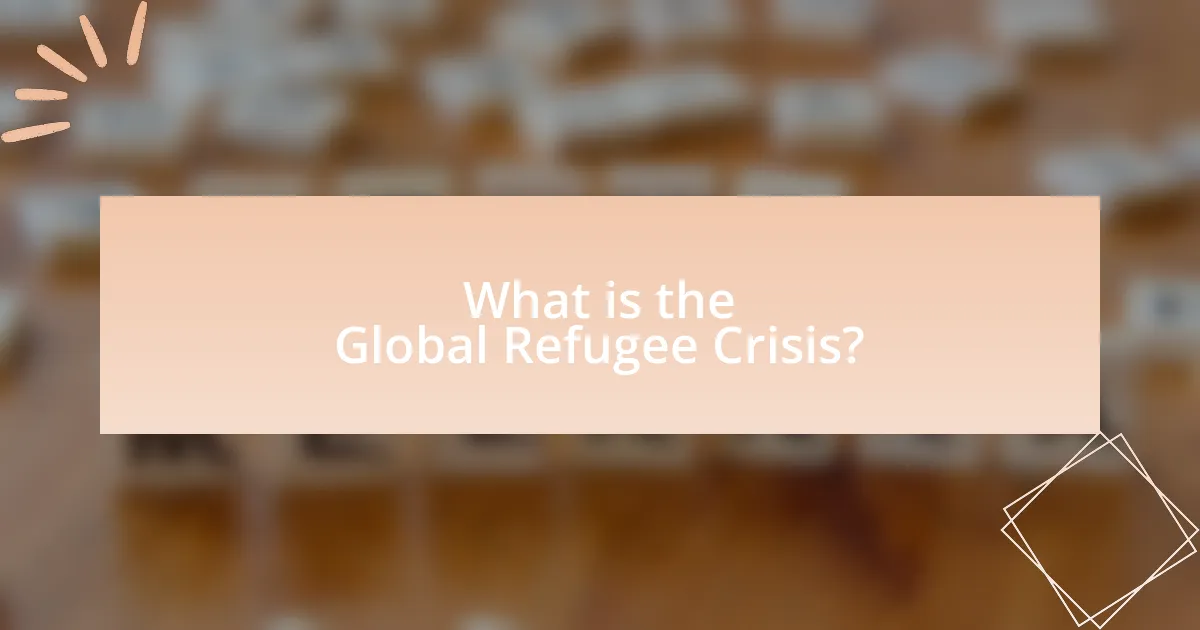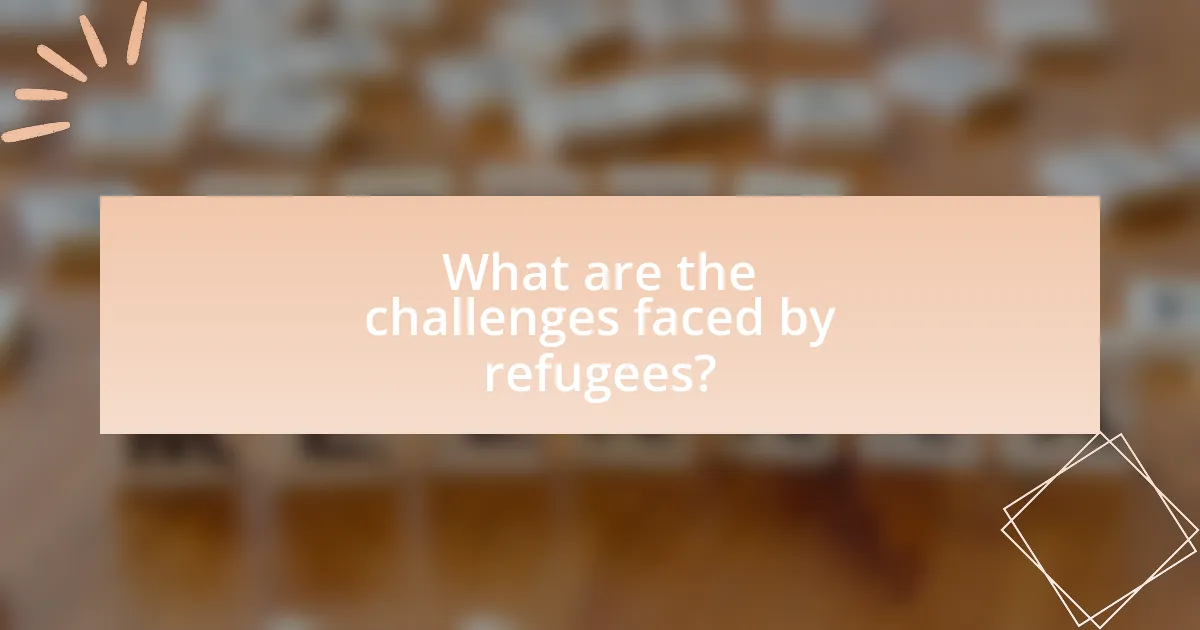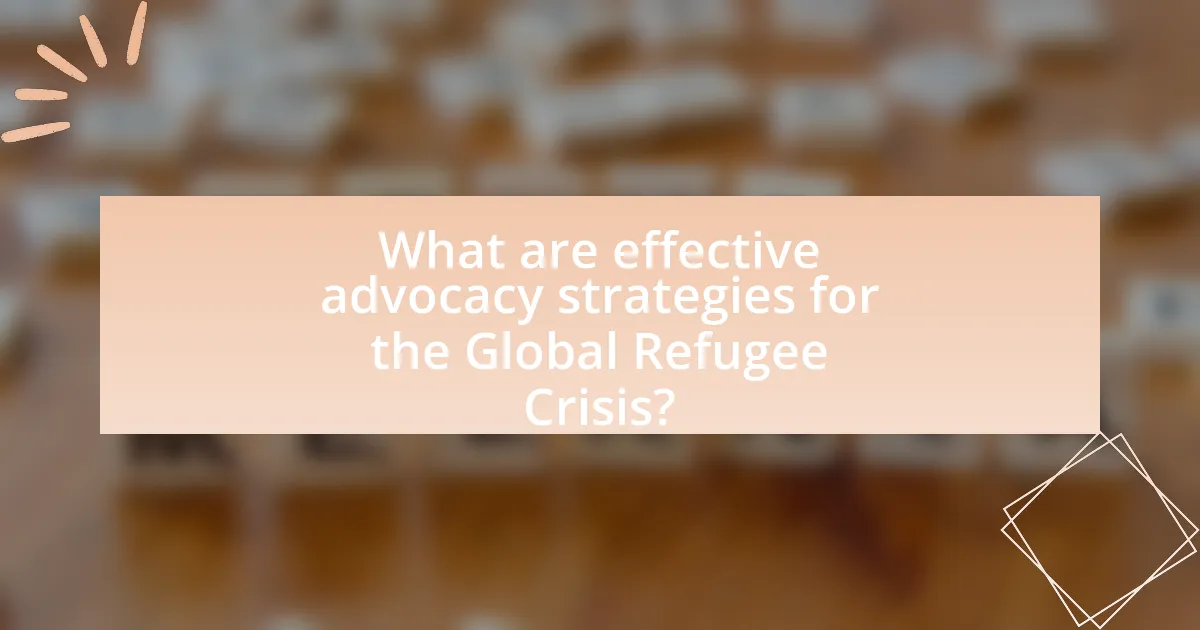The Global Refugee Crisis is characterized by the unprecedented displacement of over 32 million individuals due to conflict, persecution, and violence, as reported by the United Nations High Commissioner for Refugees (UNHCR) in 2023. This article examines the defining aspects of the crisis, including key statistics, contributing factors, and the humanitarian implications for both refugees and host countries. It highlights the challenges faced by displaced populations, the role of advocacy in addressing their needs, and effective strategies for mobilizing support and influencing policy changes. Understanding these elements is crucial for fostering international cooperation and promoting human rights for refugees globally.

What is the Global Refugee Crisis?
The Global Refugee Crisis refers to the unprecedented number of individuals who have been forcibly displaced from their homes due to conflict, persecution, or violence. As of 2023, over 26 million refugees are recorded globally, according to the United Nations High Commissioner for Refugees (UNHCR). This crisis is exacerbated by ongoing conflicts in regions such as Syria, Afghanistan, and South Sudan, where millions flee to seek safety and stability. The situation is further complicated by factors such as climate change and political instability, which contribute to the increasing number of displaced persons.
How is the Global Refugee Crisis defined?
The Global Refugee Crisis is defined as a significant and widespread displacement of individuals who are forced to flee their home countries due to persecution, conflict, violence, or human rights violations. According to the United Nations High Commissioner for Refugees (UNHCR), as of mid-2023, there are over 32 million refugees worldwide, highlighting the scale of this humanitarian issue. This crisis is characterized by the challenges faced by refugees in seeking safety and the international community’s response to their needs, including legal protections and humanitarian assistance.
What are the key statistics surrounding the Global Refugee Crisis?
As of 2023, there are approximately 32.5 million refugees worldwide, according to the United Nations High Commissioner for Refugees (UNHCR). This figure represents a significant increase from previous years, highlighting the ongoing severity of the Global Refugee Crisis. In 2022 alone, 5.5 million people were newly displaced due to conflict and persecution, with Syria, Afghanistan, and South Sudan being the top countries of origin for refugees. Furthermore, over 60% of the global refugee population is hosted in just 10 countries, with Turkey, Colombia, and Uganda leading the way. These statistics underscore the urgent need for international support and advocacy to address the challenges faced by refugees globally.
What factors contribute to the Global Refugee Crisis?
The Global Refugee Crisis is primarily driven by conflict, persecution, and environmental factors. Armed conflicts, such as the Syrian Civil War, have displaced millions, with the United Nations High Commissioner for Refugees (UNHCR) reporting over 6.6 million Syrian refugees as of 2023. Additionally, systemic persecution based on ethnicity, religion, or political beliefs, exemplified by the Rohingya crisis in Myanmar, forces individuals to flee their homes. Environmental factors, including climate change and natural disasters, exacerbate these situations, leading to increased displacement; for instance, the Intergovernmental Panel on Climate Change (IPCC) estimates that climate change could displace over 200 million people by 2050. These interconnected factors create a complex landscape contributing to the ongoing Global Refugee Crisis.
Why is understanding the Global Refugee Crisis important?
Understanding the Global Refugee Crisis is important because it highlights the urgent need for humanitarian response and policy reform to address the plight of millions displaced by conflict, persecution, and disaster. The United Nations High Commissioner for Refugees reported that as of 2022, there were over 26 million refugees worldwide, emphasizing the scale of the crisis and the necessity for global awareness and action. By comprehending the complexities of this issue, stakeholders can advocate for effective solutions, promote human rights, and foster international cooperation to support affected populations.
How does the Global Refugee Crisis impact host countries?
The Global Refugee Crisis significantly impacts host countries by straining their resources and infrastructure. For instance, countries like Turkey and Lebanon, which host millions of refugees, experience increased pressure on public services such as healthcare, education, and housing. According to the United Nations High Commissioner for Refugees (UNHCR), Turkey hosts over 3.6 million Syrian refugees, leading to challenges in providing adequate healthcare and education services. Additionally, the influx of refugees can lead to social tensions and economic challenges, as local populations may feel competition for jobs and resources. This situation is evidenced by reports indicating that in Lebanon, the presence of refugees has contributed to rising unemployment rates and increased strain on local economies.
What are the humanitarian implications of the Global Refugee Crisis?
The humanitarian implications of the Global Refugee Crisis include increased vulnerability of displaced populations, strain on host countries, and challenges in providing adequate humanitarian assistance. Displaced individuals often face threats to their safety, limited access to basic needs such as food, water, and healthcare, and psychological trauma from their experiences. Host countries, particularly those with limited resources, experience economic and social pressures, which can lead to tensions between refugees and local communities. According to the United Nations High Commissioner for Refugees (UNHCR), as of 2022, there were over 26 million refugees worldwide, highlighting the scale of the crisis and the urgent need for comprehensive support and advocacy to address these humanitarian challenges.
What role does advocacy play in addressing the Global Refugee Crisis?
Advocacy plays a crucial role in addressing the Global Refugee Crisis by raising awareness, influencing policy, and mobilizing resources for refugees. Through advocacy efforts, organizations and individuals can highlight the plight of refugees, leading to increased public support and pressure on governments to implement humane policies. For instance, the United Nations High Commissioner for Refugees (UNHCR) reported that advocacy campaigns have successfully led to the adoption of international agreements, such as the Global Compact on Refugees, which aims to enhance cooperation and support for host countries. This demonstrates that effective advocacy not only brings attention to the crisis but also fosters collaborative solutions that can improve the lives of millions of displaced individuals.
How can advocacy influence policy changes regarding refugees?
Advocacy can influence policy changes regarding refugees by mobilizing public opinion and pressuring policymakers to address refugee issues. For instance, organizations like Amnesty International and Human Rights Watch have successfully campaigned for legislative reforms by highlighting human rights violations faced by refugees, leading to changes in asylum laws in various countries. Additionally, advocacy efforts often include data-driven campaigns that present compelling evidence of the benefits of refugee integration, which can sway public sentiment and encourage governments to adopt more inclusive policies.
What are the different forms of advocacy for refugees?
Different forms of advocacy for refugees include legal advocacy, public awareness campaigns, policy advocacy, and grassroots organizing. Legal advocacy involves providing legal assistance to refugees to help them navigate immigration laws and secure their rights. Public awareness campaigns aim to educate the general public about the challenges faced by refugees, often utilizing social media and traditional media outlets to spread information. Policy advocacy focuses on influencing government policies and legislation to improve the conditions for refugees, often through lobbying efforts and collaboration with policymakers. Grassroots organizing mobilizes communities to support refugees through local initiatives, fostering solidarity and direct assistance. Each of these forms plays a crucial role in addressing the needs and rights of refugees globally.

What are the challenges faced by refugees?
Refugees face numerous challenges, including lack of access to basic needs, legal status issues, and social integration difficulties. Many refugees struggle to secure food, clean water, and shelter, as highlighted by the United Nations High Commissioner for Refugees (UNHCR), which reported that over 80 million people were forcibly displaced worldwide in 2020, with many lacking adequate resources. Additionally, refugees often encounter legal barriers that prevent them from obtaining work permits or accessing healthcare, leading to economic instability. Social integration poses another significant challenge, as refugees frequently experience discrimination and xenophobia in host countries, which can hinder their ability to build community connections and find employment.
What obstacles do refugees encounter during displacement?
Refugees encounter numerous obstacles during displacement, including violence, lack of access to basic necessities, and legal barriers. Violence often manifests in the form of armed conflict, persecution, or exploitation, which can threaten their safety and well-being. Additionally, refugees frequently face challenges in accessing food, clean water, shelter, and healthcare, leading to severe health risks and malnutrition. Legal barriers, such as restrictive immigration policies and lack of documentation, hinder their ability to seek asylum or resettle in safer countries. According to the United Nations High Commissioner for Refugees (UNHCR), over 80 million people were forcibly displaced worldwide by the end of 2020, highlighting the scale of these challenges.
How do legal barriers affect refugees’ rights?
Legal barriers significantly restrict refugees’ rights by limiting their access to asylum processes and essential services. These barriers can include restrictive immigration laws, lack of legal recognition, and inadequate legal representation, which hinder refugees from obtaining protection and basic human rights. For instance, according to the UNHCR, many countries impose stringent criteria for refugee status determination, resulting in a high rate of rejection for asylum claims. Additionally, legal frameworks that criminalize irregular entry can lead to detention and deportation, further undermining refugees’ rights to safety and security.
What are the social challenges faced by refugees in host countries?
Refugees in host countries face significant social challenges, including discrimination, lack of access to education, and limited employment opportunities. Discrimination often manifests in negative attitudes and xenophobia from local populations, which can lead to social isolation and mental health issues. Access to education is frequently hindered by language barriers and legal restrictions, preventing refugee children from integrating into the local school system. Additionally, refugees often encounter difficulties in securing employment due to their legal status, lack of recognition of their qualifications, and cultural differences, which can exacerbate their economic vulnerability and hinder their ability to contribute to society. These challenges are documented in various studies, including the UNHCR’s Global Trends report, which highlights the multifaceted struggles refugees endure in adapting to new environments.
How do these challenges impact the effectiveness of advocacy?
Challenges such as misinformation, lack of resources, and political resistance significantly diminish the effectiveness of advocacy in addressing the global refugee crisis. Misinformation can lead to public misunderstanding and decreased support for refugee initiatives, as evidenced by studies showing that negative narratives about refugees often dominate media coverage, influencing public perception. Additionally, limited resources hinder organizations’ ability to mobilize effectively, conduct outreach, and provide necessary services, which is critical for advocacy success. Political resistance further complicates advocacy efforts, as policies may be enacted that restrict refugee rights and access to services, undermining the goals of advocacy groups. These factors collectively create an environment where advocacy struggles to achieve meaningful impact, as demonstrated by the declining support for refugee resettlement programs in various countries.
What strategies can advocates use to overcome these challenges?
Advocates can use strategies such as building coalitions, leveraging social media, and engaging in policy advocacy to overcome challenges in addressing the global refugee crisis. Building coalitions allows advocates to unite various stakeholders, increasing their collective influence and resources. For instance, organizations like the United Nations High Commissioner for Refugees (UNHCR) collaborate with local NGOs to amplify their efforts. Leveraging social media enables advocates to raise awareness and mobilize public support quickly; campaigns like #WithRefugees have successfully engaged millions globally. Engaging in policy advocacy involves lobbying governments to enact supportive legislation, as seen in the Refugee Act of 1980 in the United States, which established a formal process for refugee resettlement. These strategies collectively enhance the effectiveness of advocacy efforts in addressing the complexities of the refugee crisis.
How can collaboration enhance advocacy efforts for refugees?
Collaboration can significantly enhance advocacy efforts for refugees by uniting diverse stakeholders to amplify their voices and resources. When governments, NGOs, and community organizations work together, they can share best practices, coordinate services, and create a more comprehensive support system for refugees. For instance, a study by the United Nations High Commissioner for Refugees (UNHCR) highlights that collaborative networks can improve access to legal assistance and social services, ultimately leading to better outcomes for refugee populations. This synergy not only increases the visibility of refugee issues but also fosters a more robust policy dialogue, ensuring that the needs of refugees are prioritized in decision-making processes.

What are effective advocacy strategies for the Global Refugee Crisis?
Effective advocacy strategies for the Global Refugee Crisis include raising public awareness, engaging policymakers, and building coalitions. Raising public awareness through campaigns can mobilize community support and influence public opinion, as seen in initiatives like the #WithRefugees campaign by the UNHCR, which garnered millions of signatures advocating for refugee rights. Engaging policymakers involves direct lobbying and providing evidence-based recommendations to influence legislation and funding, exemplified by organizations like Refugees International, which regularly briefs lawmakers on refugee issues. Building coalitions with NGOs, community groups, and faith-based organizations enhances advocacy efforts by pooling resources and amplifying voices, as demonstrated by the Global Refugee Coalition, which unites various stakeholders to address refugee needs collectively.
What are the best practices for refugee advocacy?
The best practices for refugee advocacy include building partnerships with local organizations, engaging in community education, and utilizing data-driven approaches to inform policy. Partnerships with local organizations enhance outreach and resource sharing, while community education fosters understanding and support for refugees. Data-driven approaches, such as utilizing statistics from the United Nations High Commissioner for Refugees, provide evidence to advocate for policy changes effectively. For instance, in 2021, there were over 26 million refugees globally, highlighting the urgent need for informed advocacy efforts.
How can grassroots movements contribute to advocacy efforts?
Grassroots movements can significantly contribute to advocacy efforts by mobilizing community support and raising awareness about specific issues. These movements often engage local populations, fostering a sense of ownership and empowerment that can lead to increased participation in advocacy campaigns. For instance, grassroots organizations have been pivotal in shaping public opinion and influencing policy changes related to the global refugee crisis, as seen in the work of groups like Refugees Welcome, which promotes community-based support for refugees. Their efforts have resulted in tangible outcomes, such as local governments adopting more inclusive policies and increased funding for refugee services, demonstrating the effectiveness of grassroots advocacy in driving systemic change.
What role do social media and technology play in advocacy?
Social media and technology serve as crucial tools in advocacy by amplifying voices, mobilizing support, and facilitating communication. They enable organizations and individuals to reach a global audience quickly, raising awareness about issues such as the global refugee crisis. For instance, platforms like Twitter and Facebook have been instrumental in campaigns that have garnered millions of views and shares, effectively influencing public opinion and policy decisions. According to a report by the Pew Research Center, 69% of adults in the U.S. use social media, highlighting its potential to engage a vast demographic in advocacy efforts. Furthermore, technology allows for real-time updates and grassroots organizing, making it easier to coordinate actions and share resources among advocates.
How can individuals get involved in advocacy for refugees?
Individuals can get involved in advocacy for refugees by volunteering with organizations that support refugee rights, such as the International Rescue Committee or Refugees International. These organizations often seek volunteers for various roles, including outreach, fundraising, and direct support services. Additionally, individuals can participate in awareness campaigns, write to their elected officials to advocate for refugee-friendly policies, and engage in community education efforts to inform others about the challenges refugees face. According to the UNHCR, there are over 26 million refugees worldwide, highlighting the urgent need for advocacy and support.
What actions can individuals take to support refugee rights?
Individuals can support refugee rights by advocating for policy changes, donating to organizations that assist refugees, volunteering their time, and raising awareness in their communities. Advocacy for policy changes can involve contacting local representatives to support legislation that protects refugees, as evidenced by the Refugee Act of 1980 in the United States, which established a formal process for refugee admission. Donating to organizations such as the United Nations High Commissioner for Refugees (UNHCR) or local nonprofits provides essential resources for refugees, with UNHCR reporting that it helps over 70 million displaced people globally. Volunteering can include offering language classes or legal assistance, which directly benefits refugees in navigating their new environments. Lastly, raising awareness through social media campaigns or community events can educate others about refugee issues, fostering a more supportive atmosphere.
How can community organizations enhance advocacy efforts?
Community organizations can enhance advocacy efforts by mobilizing grassroots support and fostering collaboration among diverse stakeholders. By engaging local communities, these organizations can raise awareness about the global refugee crisis, ensuring that the voices of affected individuals are heard. For instance, organizations like the Refugee Council in the UK have successfully utilized community outreach programs to educate the public and influence policy changes. This approach not only amplifies the message but also builds a network of advocates who can collectively push for legislative reforms. Additionally, leveraging social media platforms allows these organizations to reach a broader audience, facilitating real-time engagement and advocacy campaigns that resonate with the public.
What are the key takeaways for effective advocacy in the Global Refugee Crisis?
Key takeaways for effective advocacy in the Global Refugee Crisis include the necessity of raising awareness, building coalitions, and utilizing data-driven approaches. Raising awareness involves educating the public and policymakers about the plight of refugees, which can lead to increased support and resources. Building coalitions with NGOs, community organizations, and other stakeholders enhances the advocacy efforts by pooling resources and amplifying voices. Utilizing data-driven approaches, such as presenting statistics on refugee populations and their needs, strengthens arguments and can influence policy changes. For instance, according to the UNHCR, there were 26.6 million refugees globally in 2021, highlighting the urgent need for advocacy efforts to address their challenges effectively.